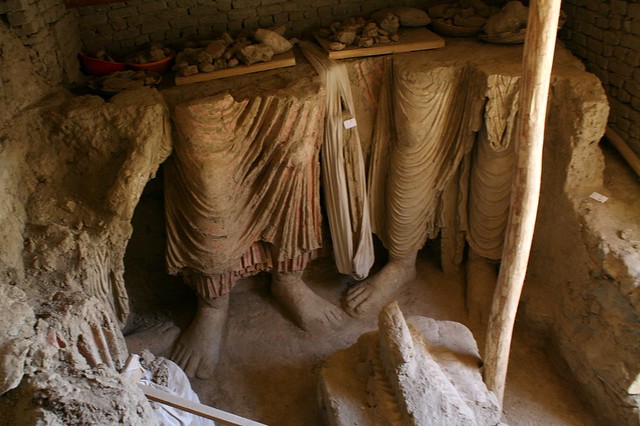 |
| Excavations at Mes Aynak ("Copper Well"), Afghanistan, a massive Buddhist temple complex in danger of demolition due to US war, Afghan desperation, and Chinese greed (Science, Vol. 329, 7-30-10/Irtiqa). |
To outrage the world and create a pretext for war, the CIA-created Taliban demolished some of the world's largest Buddha statues at Bamiyan, 125 miles to the northwest. The age of those statues is hard to pinpoint because long before they were converted to Buddhist images, monastic caves, and a rich cultural crossroads along the Silk Route, they were monolithic giants depicting humankind devolving slowly through the epochs, according to Russian psychic and Theosophist Madame Blavatsky.
 |
| Map of Mes Aynak, Afghanistan (SV) |
A precious metal and rare earth mine 25 miles southeast of Kabul, the current Afghan capital, was an enormous Buddhist temple complex 2,600 years ago. Why? The Buddha was born in the ancient region (now called Logar Province), which was once India's northwest frontier. Temples were often built near mines to draw raw materials for the ornate temple structures.
 |
| Buddhist archaeological discoveries: Mes Aynak, Tepe Naranj, Buddhist art of
the Kabul River Valley -- the first new collections to enter the Nat'l
Museum (Kabul) in 30 years come from the newly
excavated Buddhist sites of ancient Kabulistan. The
spectacular finds from two sites, Mes Aynak and Tepe Narenj, greatly
expand our understanding of the artistic culture of the region
during the expansion of Islam and the displacement of Buddhism and Zoroastrianism More |
 |
| Mes Aynak jewelry treasure (SV) |
That fabulous
1,000 hectare complex -- with various monasteries, nunneries, and other buildings -- is very ancient and is apparently set atop two older layers of a town. But Chinese government corporate interests are doing their best to make sure the world never sees most of what constitutes this archeological site. They seek to demolish it and extract its mineral wealth.
Millennia ago, this region served as a critical conduit in the spread of Buddhism to Central Asia [up to Europe and the only indigenously Buddhist portion of Europe,
Kalmykia] and China [Buddhism flourished in ancient Greece before it got to China], says T. Richard Blurton, an archaeologist and curator at London's British Museum who has excavated in Afghanistan.
 |
| The barren site hiding cultural wonders |
Blurton says Mes Aynak could provide new data on both the origin and demise of the religion here. Researchers now believe that as late as the 7th century C.E., when Islam arrived in the area, Buddhism was still making inroads as far west as Iran and as far north as Turkmenistan. "It's quite tantalizing to consider how Buddhism coexisted with the new religion."
There are also Hindu deities from that late period at Tepe Sardar, a large monastery located in the eastern Afghan city of Ghazni. Further evidence from Mes Aynak could help provide a new picture of religious blending at an important historical juncture, explains Blurton. There is some hope for compromise and coexistence -- by creating a protected zone for archeology. But it looks like the decision is now directly in the hands of US-installed Afghan leader Karzai. Read
full article (subscription may be necessary).


























































































































































































































































No comments:
Post a Comment